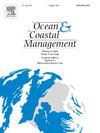Acoustic characteristics and spatiotemporal distribution of photosynthesis-related sounds in seagrass beds of Li'an Port, Hainan Province, China
IF 5.4
2区 环境科学与生态学
Q1 OCEANOGRAPHY
引用次数: 0
Abstract
The biological component of the ocean soundscape has traditionally been attributed to sounds produced by aquatic animals, with much less known about those generated by plants. In this study, we investigated the acoustic signals produced by seagrass and its epiphytic algae during photosynthesis in a seagrass bed at Li'an Port, Hainan Province, China. Photosynthetic bubbles formed monopole sound sources, and we employed passive acoustic monitoring (PAM) technology at two sites to capture associated acoustic signals. Single pulses were detected and extracted using a neural network. Acoustic signal rates rose during non-photosynthetic periods, coinciding with wave breaking, human activities, or biological disturbances. We then manually checked the signals and removed the pulses from these interference processes throughout the 19-day recording period to specifically focus on analyzing the photosynthesis signals. The acoustic characteristics, including sound pressure level (SPL), duration, peak frequency, and −3 dB bandwidth were analyzed to assess differences between the sites. Photosynthesis-related acoustic signal rates peaked in the afternoon, and its average signal rate showed a roughly parallel trend to that of dissolved oxygen (DO) and temperature. These findings suggest that PAM of photosynthetic bubbles revealed another biological component of the overall ocean soundscape. This approach may advance research on quantifying primary productivity in aquatic systems and promises to serve as a valuable tool for rapid, direct assessment of ecosystem health with capacity for long-term continuous monitoring.
海南黎安港海草床光合相关声音的声学特征及时空分布
传统上,海洋声景的生物成分被认为是水生动物发出的声音,而植物发出的声音则鲜为人知。本研究以海南黎安港海草床为研究对象,研究了海草及其附生藻类在光合作用过程中产生的声信号。光合气泡形成单极声源,我们在两个地点采用被动声监测(PAM)技术捕捉相关的声信号。利用神经网络对单脉冲进行检测和提取。在非光合作用时期,声信号率上升,与波浪破裂、人类活动或生物干扰相一致。然后,我们在19天的记录期内手动检查信号并从这些干扰过程中去除脉冲,以专门分析光合作用信号。声学特性,包括声压级(SPL),持续时间,峰值频率和- 3db带宽进行分析,以评估站点之间的差异。与光合作用相关的声信号率在下午达到峰值,其平均信号率与溶解氧(DO)和温度的平均信号率大致平行。这些发现表明光合气泡的PAM揭示了整个海洋声景的另一个生物成分。这种方法可以推进水生系统初级生产力的量化研究,并有望成为一种有价值的工具,用于快速、直接评估具有长期连续监测能力的生态系统健康。
本文章由计算机程序翻译,如有差异,请以英文原文为准。
求助全文
约1分钟内获得全文
求助全文
来源期刊

Ocean & Coastal Management
环境科学-海洋学
CiteScore
8.50
自引率
15.20%
发文量
321
审稿时长
60 days
期刊介绍:
Ocean & Coastal Management is the leading international journal dedicated to the study of all aspects of ocean and coastal management from the global to local levels.
We publish rigorously peer-reviewed manuscripts from all disciplines, and inter-/trans-disciplinary and co-designed research, but all submissions must make clear the relevance to management and/or governance issues relevant to the sustainable development and conservation of oceans and coasts.
Comparative studies (from sub-national to trans-national cases, and other management / policy arenas) are encouraged, as are studies that critically assess current management practices and governance approaches. Submissions involving robust analysis, development of theory, and improvement of management practice are especially welcome.
 求助内容:
求助内容: 应助结果提醒方式:
应助结果提醒方式:


